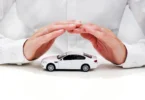Rental car insurance works differently than regular car insurance. In most states, every rental car needs a basic set of three types of insurance to get on the road, but how they work varies.
Almost all over the world, rental cars need three basic types of insurance to get you on the road: damage coverage (commonly called collision damage protection), theft coverage (theft protection), and third-party coverage ( third party insurance).
1) Protection Against Damage in the Event of a Collision
Basic Vehicle Damage Coverage (usually called Collision Damage Protection or CDW) protects you if the vehicle body is damaged. Like most types of coverage, collision damage insurance always includes a maximum cost, which is the amount you’ll have to pay for repairs if the bodywork is damaged. The maximum amount varies depending on where you rent, the rental company you work with and the type of car, but the amount is usually between €600 and €3,500.
Collision damage protection covers the vehicle’s exterior only. If, for example, windows, wheels or the interior structure of a vehicle are damaged, you will pay the full cost of repairing the damage and any administration fees (unless you have purchased additional coverage).
2) Protection Against Theft
A thief breaks into a car by smashing its snow-covered window
Anti-theft protection covers the rental car in the event of it being stolen, as well as repairing damage to the car caused by the thief attempting to steal it.
Theft Protection (sometimes abbreviated as TP) provides coverage in the event of theft or attempted theft of your vehicle. Anti-theft protection always includes the maximum costs, which is the part of the bill you’ll pay if the vehicle is stolen or damaged when attempted theft.
The maximum amount varies depending on where you rent, the rental company and the type of car, but the amount is usually between €600 and €3,500.
You may sometimes see the term “Loss Damage Waiver (LDW”) used in the USA. It combines collision and theft protection.
3) Third Party Insurance
Third Party Insurance (sometimes abbreviated TPL) covers costs if you hurt anyone or anything with your rental car. It does not cover the rental car itself. There is usually a limit to the amount covered by third party insurance.
There are no cap costs in this type of policy.
What Type of Insurance Is Included Automatically?
Almost everywhere in the world, any road rental car will have basic damage, theft and third party coverage covered.
If you are from Europe or most other parts of the world, damage, theft and third party coverage is usually included in the price when you book your car. Collision damage protection and theft protection usually have maximum costs. The cap costs are the first part of paying for repairs or other costs. Things work a little differently for drivers from the US or Canada. Many North American drivers have credit cards that automatically include rental car coverage. Therefore they may be able to choose a Basic (or “Standard”) package, which does not provide protection against damage or theft, or an all-inclusive package that provides all of the above. (But the Basic or Standard plan includes 3rd party insurance.)
It is worth noting that all types of coverage are linked to the rental agreement that the driver signs upon receiving the vehicle. If the driver breaches the terms of the rental agreement, the renter will have to pay the full cost of any repair or replacement of the vehicle if it is stolen.
Optional Insurance That Renters Can Buy
You can choose to buy additional insurance to cover the maximum costs (meaning you won’t pay anything for the repairs) and insure the other parts of the rental car. This is not a legal requirement, so it is up to the renter whether or not to purchase additional insurance.
There are three popular ways to add additional insurance to a rental car:
- Add insurance when booking a car online: Many car rental sites, including Rentalcars.com, sell their own type of coverage. They are all different, but they may all cover parts not limited to the vehicle’s exterior (eg windows, tyres, engine, etc.), and/or reduce your cap costs. If you buy this type of coverage, you will usually pay the rental company for any repairs first, and then apply for a refund from the insurance company you bought the coverage from.
- Buy car rental insurance online independently: You can choose to purchase insurance from a different insurance company. There are many online options specifically designed for car rental. It is often sold as a ‘Maximum Cost Protection Insurance’. If you buy this type of coverage, you will pay the rental company for the repairs first, and then apply for a refund from the company you bought the coverage from.
- Buying coverage upon receipt of a rental car : Rental companies offer their own additional coverage at the rental desk. The price, name and types of insurance vary depending on the rental company and where you are renting. The insurance will likely cover parts that are not limited to the vehicle’s exterior such as: windows, tyres, engine, etc.), and/or lower your maximum costs (the amount you’ll pay if any damage occurs). Cap-free policies completely remove cap costs, so you pay absolutely nothing for everything that’s covered.







